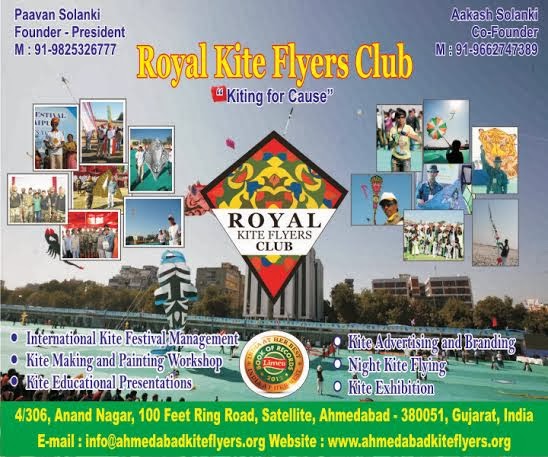Indian Fighter Kites and Kite Fighting Tradition in India
 Kites in India
Kites in India
India has a very ancient kite tradition. Most people believe that kites were first brought into India by
the Chinese travellers, Fa Hien and Hiuen Tsang but from there the kites have taken their own
evolutionary route in India and today Indian kites are almost exclusively fighter kites. They are made of tissue paper and bamboo and almost all Indian kites have a very similar shape –
a diamond shaped piece of tissue with a central spine and a single bow. The differences lie in the many patterns and colours used to make the paper sail. But the Indian kite is a superb flying machine, capable of responding to the flyers’ lightest touch, extremely maneuverable and perfectly suited to
its function. The generic name for a kite in India is
Patang
.
Types of Indian kites
While the basic shape of the Indian kite remains largely unchanged from the diamond, there are subtle variations – and each has its fervent supporters.
subtle variations – and each has its fervent supporters.
Patang
– This is the most common Indian kite. The height/width ratio is generally 1:1.2. As in all
Indian kites, the edges are reinforced by a thin thread along the circumference of the kite and the
overlapping paper is glued back on to the sail. This is a tail-less kite. The tail is generally a small
double triangular piece of tissue, pasted such that the bottom edge is flush with the level of the sail,
with thin bamboo slivers along the outer edges for reinforcement.
Guddi
– Almost as popular as the patang, this variation generally has a height/width ratio in reverse –
1.2 : 1. In other words, the kite is taller than it is wide. The tail in this kite is generally a small tassel
of tissue paper.
Dedh Kanni
– This is a little more uncommon and is generally used in lower winds – The kite is significantly broader than the regular patang and the height/width ratio tends to be close to 1:1.5. It shares the triangular patch tail with its parent patang.
triangular patch tail with its parent patang.
Tukkal
– This shape is more akin to the Malaysia Wau than the patang and is almost never seen in Indian skies except at Kite Festivals. In Pakistan, though, it is still a popular design.
Twin double-bows make this a very “heavy” kite and not many people possess the skill to fly it. Besides, the time and energy required to make one make it a precious object, one you
wouldn’t like to lose by risking it in a kite battle
Source : Nomad Trust
 Kites in India
Kites in IndiaIndia has a very ancient kite tradition. Most people believe that kites were first brought into India by
the Chinese travellers, Fa Hien and Hiuen Tsang but from there the kites have taken their own
evolutionary route in India and today Indian kites are almost exclusively fighter kites. They are made of tissue paper and bamboo and almost all Indian kites have a very similar shape –
a diamond shaped piece of tissue with a central spine and a single bow. The differences lie in the many patterns and colours used to make the paper sail. But the Indian kite is a superb flying machine, capable of responding to the flyers’ lightest touch, extremely maneuverable and perfectly suited to
its function. The generic name for a kite in India is
Patang
.
Types of Indian kites
While the basic shape of the Indian kite remains largely unchanged from the diamond, there are
 subtle variations – and each has its fervent supporters.
subtle variations – and each has its fervent supporters.Patang
– This is the most common Indian kite. The height/width ratio is generally 1:1.2. As in all
Indian kites, the edges are reinforced by a thin thread along the circumference of the kite and the
overlapping paper is glued back on to the sail. This is a tail-less kite. The tail is generally a small
double triangular piece of tissue, pasted such that the bottom edge is flush with the level of the sail,
with thin bamboo slivers along the outer edges for reinforcement.
Guddi
– Almost as popular as the patang, this variation generally has a height/width ratio in reverse –
1.2 : 1. In other words, the kite is taller than it is wide. The tail in this kite is generally a small tassel
of tissue paper.
Dedh Kanni
– This is a little more uncommon and is generally used in lower winds – The kite is significantly broader than the regular patang and the height/width ratio tends to be close to 1:1.5. It shares the
 triangular patch tail with its parent patang.
triangular patch tail with its parent patang.Tukkal
– This shape is more akin to the Malaysia Wau than the patang and is almost never seen in Indian skies except at Kite Festivals. In Pakistan, though, it is still a popular design.
Twin double-bows make this a very “heavy” kite and not many people possess the skill to fly it. Besides, the time and energy required to make one make it a precious object, one you
wouldn’t like to lose by risking it in a kite battle
Source : Nomad Trust

No comments:
Post a Comment